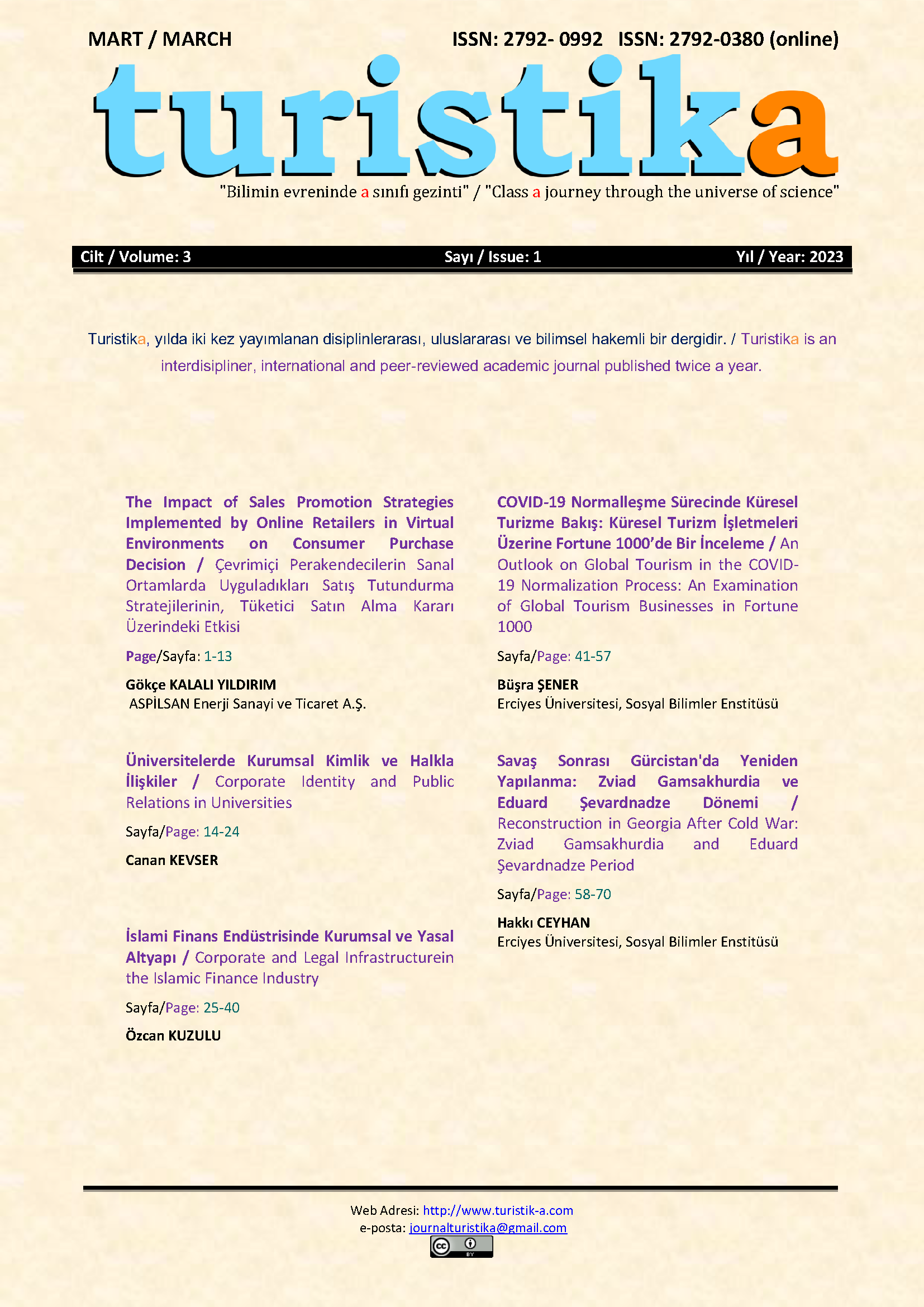Makaleler

Published 31.03.2023
Keywords
- Islamic finance,
- Legal regulation,
- Audit,
- Institutional structure,
- Islamic Development Bank
- İslami finans,
- Yasal düzenleme,
- Denetim,
- Kurumsal yapı,
- İslam Kalkınma Bankası
How to Cite
Corporate and Legal Infrastructurein the Islamic Finance Industry. (2023). Elegest Elegeş, 3(1), 25-40. https://doi.org/10.64360/khhay398
Copyright (c) 2025 Özcan Kuzulu (Yazar)

This work is licensed under a Creative Commons Attribution-NonCommercial-NoDerivatives 4.0 International License.
How to Cite
Corporate and Legal Infrastructurein the Islamic Finance Industry. (2023). Elegest Elegeş, 3(1), 25-40. https://doi.org/10.64360/khhay398
Abstract
The Islamic finance industry is one of the fastest growing and most researched topics of the last fifty years. During this time, of course, the role of institutionalization in this development is great. In particular, the establishment of the institutional structure that started in the world in the 1970s led to the issue of interest-free finance being brought to the agenda in Turkey in the 1980s. Winking at an open economy with the January 24 Decisions, Turkey wanted to get a share from the foreign exchange reserves that were accumulating rapidly due to the rising oil prices in its nearby geography. In the study, the legal development of the interest-free finance industry has been revealed step by step since then. In addition, today, both the strengthening of the legal ground and the institutions that function in supervision have been transferred. In the world, it is seen that international organizations such as the Islamic Cooperation Organization (OIC) and the Islamic Development Bank (IDB) play an important role in the development of Islamic finance. In addition to these institutions, there are international institutions that pave the way for the development of the Islamic finance industry in matters such as supervision, regulation, financing and education. It is aimed to contribute to the literature by presenting all this national and international structure holistically.
References
- Akdemir, S. (2017). Faizsiz finans kanun taslağına yönelik eleştiri ve öneril er: İslam iktisadı ilkelerine göre bir değerlendirme. JIEF
- Journal of Islamic Economics and Finance, 3 (2), 161-186.
- Balz, K. (2008). Sharia risk?
- http://www.law.harvard.edu/programs/ilsp
- BDDK. (2018). TKBB Danışma kurulu kararı. BDDK. https://tkbbdanismakurulu.org.tr/uploads/b elgeler/BDDK-Kurul-Karari.pdf
- Bhatti, M. (2019). Managing shariah non- compliance risk via Islamic dispute resolution. Journal of Risk and Financial
- Management, 13(1), 2.
- https://doi.org/10.3390/jrfm13010002
- Çemberlitaş, İ. (2019). AAOIFI ve UFRS’ye göre teverruk uygulaması muhasebeleştirilmesi ve raporlanması. Doktora Tezi, İnönü Üniversitesi.
- Çürük, S. A. (2013). İslami finansın Türkiye’deki gelişimi, mevcut sorunlar ve çözüm önerileri. Doktora Tezi, Selçuk Üniversitesi.
- Dede, K. (2017). Katılım Bankalarında Hazine Ürünleri ve Sermaye Piyasası Uygulamaları. Türkiye Katılım Bankaları Birliği.
- http://www.tkbb.org.tr/Documents/Yonetm elikler/sermayepiyasalariuygulamalari.pdf
- Dinç, Y. (2016). Katılım bankalarının danışma kurullarının kurumsal yönetim unsuru olarak değerlendirmesi. İslam Ekonomisi ve Finansı Dergisi (İEFD), 2(2), 83-103.
- http://dergipark.gov.tr/jief/issue/27745/293 244
- Ersoy, M., Çatıkkaş, Ö., & Yatmaz, A. (2018). İslami muhasebenin geleneksel muhasebe ile
- karşılaştırmalı olarak incelenmesi.
- Uluslararası İslam Ekonomisi ve Finansı Araştırmaları Dergisi, 4(1), 96-110.
- https://doi.org/10.25272/j.2149- 8407.2018.4.1.06
- Ertugay, E., Gülençer, İ., Karabayır, M. E., & Doğan, M. (2019). Faizsiz finansal kuruluşların
- denetimi. 3. Sektör Sosyal Ekonomi Dergisi, 54(3), 1442-1457.
- https://doi.org/10.15659/3.sektor-sosyal- ekonomi.19.09.1199
- Faizsiz finans standartları. (2023).
- https://www.kgk.gov.tr/
- Ginena, K., & Hamid, A. (2015). Foundations of
- shari'ah governance of Islamic banks. Wiley. https://doi.org/10.1002/9781119053507
- Güçlü, F., & Kılıç, M. (2020). İslami finansın
- dünya’daki gelişimi ve islami finansa yön veren uluslararası kuruluşlar üzerin e bir
- inceleme. International Journal of Management Economics and Business, 16(1), 75-91.
- https://doi.org/10.17130/ijmeb.700891
- Güney, N. (2015). İslami finansta şer’i yönetim uygulamaları ve konuyla ilgili tartışmalara genel bir bakış. Turkish Journal of Islamic Economics, 2(2), 45-45.
- https://doi.org/10.15238/tujise.2015.2.2.45- 69
- Iqbal, Z., & Mirakhor, A. (2011). An introduction to Islamic finance: Theory and Practice (J. W. & S. (Asia) (Ed.); 2nd ed.).
- İslam Kalkınma Bankası. (2022). İslam Kalkınma Bankası. İslam Kalkınma Bankası.
- https://www.isdb.org/
- Kartal, M. T., & Ay, H. (2019). Türkiye’de faizsiz finans kuruluşları açısından bir dönüm noktası: faizsiz finans muhasebe standartları üzerine bir inceleme. Journal of iİnternational Banking Economy and Management Studies, 2(1), 77-102.
- Kettell, B. (2011). Introduction to Islamic banking and finance. A John Wiley and Sons, Ltd.
- Mevzuat ve standartlar. (2023). Türkiye
- Cumhuriyeti Cumhurbaşkanlığı Finans Ofisi. https://www.cbfo.gov.tr/mevzuat-ve- standartlar
- Ouendi, L. (2015). La Finance İslamique Face Aux Defis de la Globalisation Financiere. Yüksek Lisans Tezi, Üniversite Mouloud Mammeri de Tizi-Ouzou.
- Tekbaş, M. Ş. (2013). İslami Finans - İslamî Finans Kavramı, Ürünler, Dünyada ve Türkiye’de Gelişimi ve Geleceği. Içinde Araştırma Notları - 1.
- TKBB. (2023a). Banka mukayese.
- https://tkbb.org.tr/veri/bankamukayese
- TKBB. (2023b). Tarihsel süreç. TKBB. https://tkbb.org.tr/sayfa/detay/hakkimizda/t arihce-856934
- Türker, H. (2010). İslami Finans Sisteminde Finansal Aracılık. Içinde Sermaye Piyasası Kurulu Aracılık Faaliyetleri Dairesi. Sermaye Piyasası Kurulu Aracılık Faaliyetleri Dairesi.
- Yahşi, F. (2001). Özel finans kurumlarının mevzuat serüveni. Al Baraka Türk Bereket Dergisi. https://tkbbegitim.org.tr/Documents/KoseYa zilari/20130724152628.pdf

